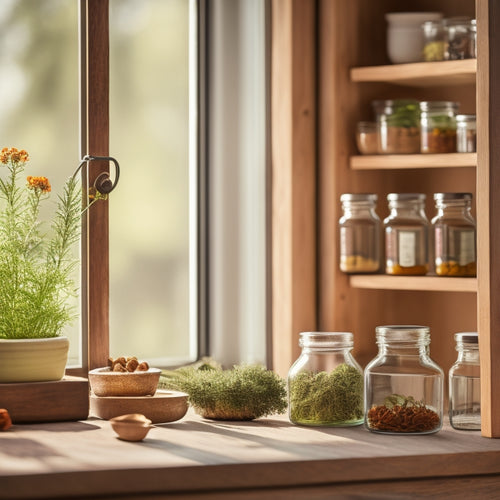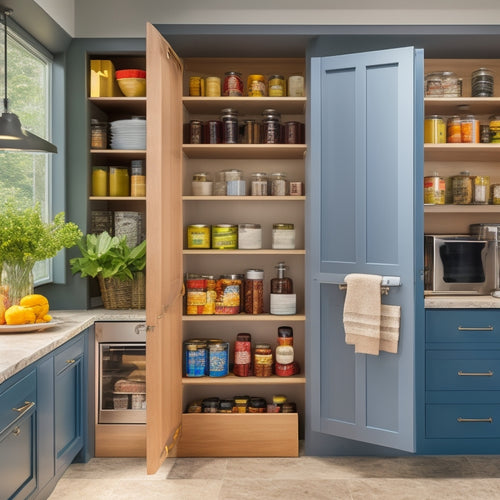
5 Essential Tips for Clutter-Free Kitchen Cabinets
Share
You're on a mission to declutter your kitchen cabinets and make meal prep a breeze. First, assess your cabinet space by mapping out the layout and identifying underutilized areas. Next, purge items that are broken, outdated, or never used. Then, categorize remaining items by function or type, and store them in designated zones. Make the most of vertical storage with shelves, baskets, or racks. Finally, establish a maintenance routine to stay on top of clutter. By following these essential tips, you'll be well on your way to achieving a clutter-free kitchen - and discovering even more secrets to a stress-free cooking experience.
Key Takeaways
• Assess kitchen cabinet space by measuring cabinets, mapping contents, and identifying underutilized areas for optimized storage.
• Purge unnecessary items by eliminating broken, outdated, or unused items, considering sentimental value and frequency of use.
• Categorize and group remaining items by function or type, creating Label Zones and maintaining organization for easy access.
• Utilize vertical storage efficiently with shelves, baskets, racks, and hooks to maximize space without sacrificing accessibility.
• Establish a regular maintenance routine with daily check-ins, seasonal deep cleans, and regular tidying to prevent clutter accumulation.
Assess Your Kitchen Cabinet Space
Take stock of your kitchen cabinet space by opening every cabinet and drawer to get a good look at what's inside and what's not. This is your chance to assess what you have, what you need, and what you can let go of.
Start by taking note of the cabinet measurements, including the width, height, and depth of each one. This will give you a clear understanding of the space you're working with.
Next, create a space map by sketching out a rough diagram of your cabinets and drawers. Identify areas that are currently cluttered or disorganized, and think about how you can optimize those spaces.
Consider the items you use most frequently and where they're currently stored. Are they easily accessible, or do you have to dig through clutter to find them?
Take note of any areas that are underutilized, such as the back of a cabinet door or the top shelf of a pantry.
Purge Unnecessary Kitchen Items
You'll be amazed at how much clutter you can eliminate by getting rid of kitchen items that are broken, outdated, or simply no longer useful to you. It's time to be honest with yourself - when was the last time you used that blender or set of fondue forks? Be ruthless and let them go.
| Reason to Keep | Reason to Purge |
|---|---|
| It's in good condition and you use it regularly | It's broken beyond repair |
| You have sentimental value attached to it | You haven't used it in the past year |
| It's essential for a specific cooking task | It's a duplicate of something you already have |
| It's part of your Kitchen Hierarchy | You're holding onto it due to Emotional Attachment |
Categorize and Group Similar Items
Now that you've purged your kitchen of unnecessary items, categorize the remaining items into groups based on their function or type, such as baking supplies, cooking utensils, or dinnerware. This step is essential in creating a clutter-free kitchen cabinet.
By grouping similar items together, you'll be able to see what you have, where it's stored, and how often you use it.
Create Label Zones within your cabinets to designate specific areas for each group. For instance, you can have a 'Baking Zone' for all your baking supplies, a 'Cooking Zone' for your cooking utensils, and so on.
This will help you maintain the organization and make it easier to find what you need when you need it.
Consider the Item Flow when grouping your items. Think about how you use your kitchen and the order in which you need items.
Store the most frequently used items in easy-to-reach locations, and less frequently used items towards the back or on higher shelves.
Use Vertical Storage Efficiently
To maximize your kitchen's storage potential, utilize the vertical space in your cabinets by installing shelves, baskets, or racks that allow you to stack items without compromising accessibility. This will help you make the most of your cabinet's vertical space, keeping frequently used items within easy reach while storing less frequently used items towards the top or bottom.
Consider installing adjustable shelves that can be tailored to fit different-sized items, ensuring you're making the most of your storage space. You can also use magnetic hooks to hang items like spices, oils, or utensils, freeing up shelf space for bulkier items.
Additionally, consider using stackable containers or baskets to store dry goods, keeping them organized and easily accessible. By optimizing your vertical storage, you'll be able to fit more items in your cabinets without sacrificing ease of access, making your kitchen feel more spacious and organized.
Implement a Maintenance Routine
Establishing a regular maintenance routine helps keep your kitchen cabinets clutter-free and organized by setting aside time each week to tidy up and address any storage issues that may arise.
You'll be surprised at how quickly clutter can accumulate, making it essential to stay on top of things. Start by incorporating daily check-ins into your routine, where you quickly scan your cabinets and countertops to make sure everything is in its place. This habit will help you catch any messes before they get out of hand.
Additionally, schedule seasonal deep cleans to give your cabinets a thorough once-over. This is the perfect opportunity to reorganize, declutter, and wipe down shelves.
Frequently Asked Questions
Can I Use Open Shelves for Storing Heavy Kitchen Items?
You can use open shelves for storing heavy kitchen items, but be mindful of visual weight; incorporate shelf dividers to create separate zones, ensuring stability and making it easier to access what you need quickly.
How Do I Prevent Moisture Buildup in Kitchen Cabinets?
You'll prevent moisture buildup in kitchen cabinets by ensuring proper cabinet ventilation and using moisture absorbers, like silica gel packets or activated charcoal, to absorb excess humidity and keep your cabinets dry and fresh.
Are Adhesive Hooks Suitable for Hanging Kitchen Utensils?
Did you know 75% of homeowners struggle with kitchen clutter? You can hang kitchen utensils using adhesive hooks, but consider hook placement and utensil selection carefully to guarantee a sturdy hold and convenient access.
Can I Store Kitchen Trash Cans Inside Cabinets?
You're considering storing kitchen trash cans inside cabinets, but think twice - it can lead to odor control issues. Instead, optimize space by placing them in a well-ventilated area, keeping your kitchen fresh and clean.
Do I Need to Label Every Single Item in My Kitchen Cabinets?
"You're not expected to label every single item, but a thousand times yes, labeling key categories will save your sanity! Implementing labeling strategies tailored to your personal organization style will help you quickly find what you need."
Related Posts
-

Spice Rack With Integrated Herb Garden
A spice rack with an integrated herb garden alters your kitchen into a culinary haven. You'll have fresh herbs at you...
-

Under-Sink Storage Bins for Organized Kitchens
Under-sink storage bins are your best bet for an organized kitchen. They maximize unused cabinet space and enhance it...
-

Affordable Sliding Pantry Drawer Solutions
If you're looking for affordable sliding pantry drawer solutions, you're in the right place. These drawers maximize s...


